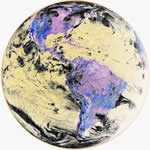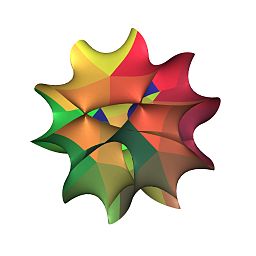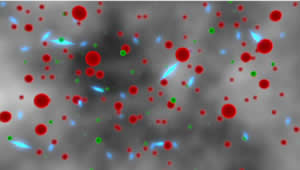White Holes: The Other Side of Black Holes
By Gaurav & Brook Bhagat
I was watching the documentary Master of the Universe, by Stephen Hawking, and I remembered my own ideas of who we are and where we come from. Although my ideas have some basis in currently accepted scientific theories, they are still mostly imagination, and I can’t provide any mathematical or physical proof for them. Enjoy the imagination, and build upon it if you wish to.
String theory states that all particles are nothing but different vibrating strings of matter. A string is to an atom roughly as a human is to our known universe in size. It reminds me of the words nad Brahma, from India’s ancient past, which means that sound (waves) is the creator. This is pretty close to what the string theory theorizes now.
Scientists struggle to combine Einstein’s theory of relativity with string theory. Einstein’s theory of relativity explains how things work at large, and String theory explains how they work on the quantum level. But when we try and combine these two, they seem to not work together. The rules of physics seem to break down, especially in case of singularities, also known as black holes.
Quantum physicists predict that there can be as many as 11 or more dimensions other than our own. Particles from our three-dimensional space migrate to other dimensions and appear back frequently. When an electron disappears from our space and comes back at some other place, where does it go? It’s not in our visible universe. Building upon it, I think that it migrates to one of the other dimensions. How can it come back to our dimension so easily? And if one electron can do that, then why doesn’t the rest of the matter in other dimensions pop out in our own?
The answer to that question will require some creative thinking. Let’s go to our Big Bang event. As Stephen Hawking explains, our Big Bang was nothing but an eruption of a big black hole and all the fundamental forces were combined in one super force before the eruption. The question arises: Why did it happen, and why here and not somewhere else? Why only four kinds of fundamental forces? Why not three or five or any other arbitrary number?
The more I think about it, the more I get imaginative. Let’s go back to the concept of the black hole for our answers. A black hole is a collapsed star with such enormous gravitational force, even light cannot escape.
To understand a black hole, think of a star as you sitting on a bed, and when you put a ball near you it tries to roll in the hole created by your weight. On a larger scale, that hole you created is called the warping of space. The gravity of massive objects warp our three dimensional space, and when some other object comes close to that heavenly body, it falls in that warp and starts moving towards it in a slow circular motion. It takes billions or even trillions of years for both of them to fall into each other.
To understand a black hole, I will give another example. A star is massive and has lots of matter; it has immense gravity, but the matter is still intact. A hydrogen atom is still hydrogen atom. A star stays in its form by a critical balance of the energies which are forcing it outward and inward. Gravity tries to pull everything inwards. When a large star burns up its fuel, gravity starts getting an edge over other energies pulling the star outwards. And, when gravity wins, the star collapses, and becomes a black hole.
Let’s imagine our space as a thin paper sheet which can hold the weight of a few empty cardboard boxes, which represent matter. If we have a bunch of them and we put them spread out over that thin paper floor, it might be able to hold their weight if it’s equally distributed on the whole floor. It will warp the floor, but still won’t break it. But, if we take out all the space from the cardboard boxes by flattening them and combining them in one stack, what happens? The floor collapses. It breaks down, and that’s precisely what happens when a star collapses onto itself. All that matter which was occupying a large space in our space tries to fit in a very small space because atoms break down to particles and possibly even further, and space is not able to hold so much mass in some very small space. At a critical point it creates a hole in our space-- a black hole is born. Its gravity starts pulling matter around it and starts compressing it, as it did to itself.
But does that mean the matter which goes in a black hole disappears? I think that’s not the case. What happens in a black hole is that it crushes the matter and takes out all the extra space between the molecules and strings, or even beyond the strings if we come to know that level of smallness in the future. All that condensed matter goes to other dimensions.
Now, let me expand a little about matter appearing in our dimension from other dimensions. We know now that our space, which we thought was empty, is not really empty, but is full of matter which has significant mass which is not visible to us yet. There are particles which appear in space randomly, containing positive mass and negative mass, and they annihilate each other when they meet each other. Small particles can do that because our dimension has small pockets of empty space, but enormous mass from other dimension cannot erupt into ours because our space is teaming with particles and mass, and doesn’t have a weak spot for so much matter to erupt.
What will happen in a few trillion or quadrillion years to our universe? We know that the universe is expanding; everything in our universe is running away from each other at a great speed. In some trillion or more years, we will have huge gaps between galaxies, and in some distant future, perhaps the density of mass in our universe will become so thin that it won’t be able to stop mass from other dimensions from erupting into our own. The weakest pocket in this space will be the point where the new big bang will happen-- the same as how our Big Bang happened. And, that will be the beginning of a new universe with its own physical properties and rules, depending on how the eruption occurs and matter breaks down in strings again. Different sized strings will create different kinds of particles and different sets of everything we know. We might see more or less than the four fundamental forces which we see in our universe.
We can call these eruptions a white hole or a Big Bang. Contrary to the black hole, a white hole is where matter comes out from and gets uncondensed, finding suitable conditions and available space. Matter comes out with so much force that the eruption creates a bubble around it which becomes a new universe with its own big bang.
Since string size is arbitrary and infinite in number as well as particles, it’s very difficult but still possible to have the same set of rules as our universe in one of these eruptions somewhere in space. We can find universes which are governed by the same rules as ours, or at least quite similar. There can be universes which are microscopic compared to our own, or so vast that our universe looks microscopic in front of them, depending on the size of the white hole from which it was born.
Another phrase from ancient India is jeevan chakra, which means the circle of life. Life is cyclical, just like our universe, exploding and imploding in black and white holes, coming to life and death on its own again and again. The finer energies will keep playing the game of life forever, and this circle will go on…
Here is the latest creation, "At the Edge," by world-known musician and Blue Planet Journal writer Chinmaya Dunster. Check out his articles in our travel section.
Did you like the article? Subscribe here to our New Article Email Alert or RSS feeds.
Sharing is caring! Don't forget to share the love, and keep the conversation going by leaving a comment below:
Advertisement


 Andrew J. Hanson, Indiana University. [
Andrew J. Hanson, Indiana University. [
